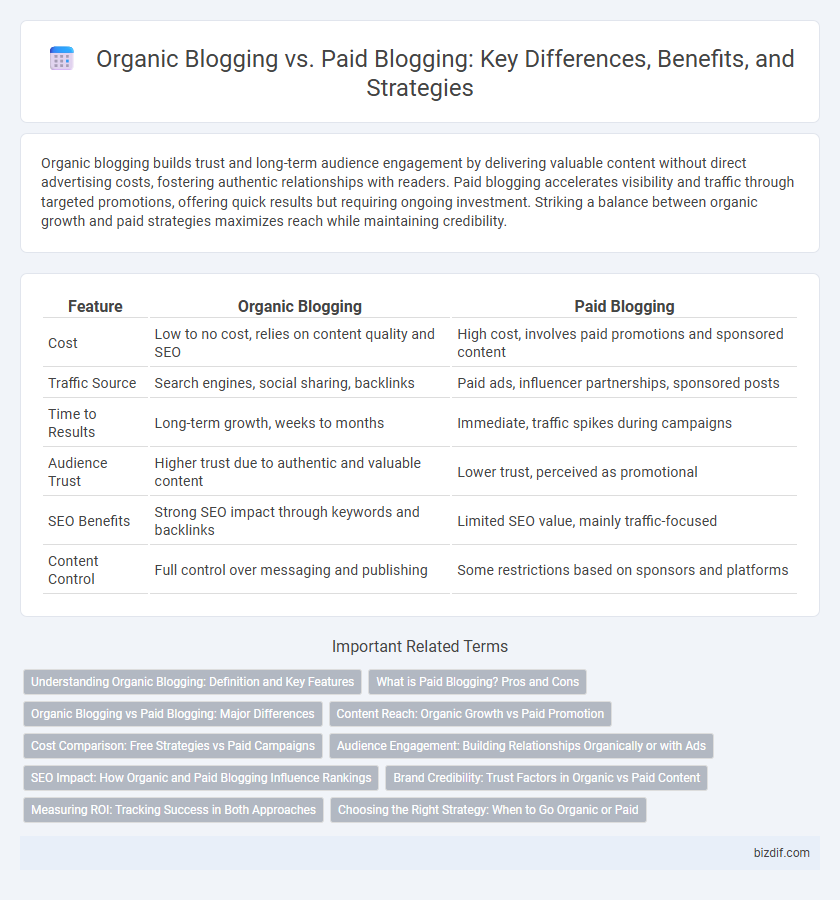Organic blogging builds trust and long-term audience engagement by delivering valuable content without direct advertising costs, fostering authentic relationships with readers. Paid blogging accelerates visibility and traffic through targeted promotions, offering quick results but requiring ongoing investment. Striking a balance between organic growth and paid strategies maximizes reach while maintaining credibility.
Table of Comparison
| Feature | Organic Blogging | Paid Blogging |
|---|---|---|
| Cost | Low to no cost, relies on content quality and SEO | High cost, involves paid promotions and sponsored content |
| Traffic Source | Search engines, social sharing, backlinks | Paid ads, influencer partnerships, sponsored posts |
| Time to Results | Long-term growth, weeks to months | Immediate, traffic spikes during campaigns |
| Audience Trust | Higher trust due to authentic and valuable content | Lower trust, perceived as promotional |
| SEO Benefits | Strong SEO impact through keywords and backlinks | Limited SEO value, mainly traffic-focused |
| Content Control | Full control over messaging and publishing | Some restrictions based on sponsors and platforms |
Understanding Organic Blogging: Definition and Key Features
Organic blogging involves creating valuable, engaging content that naturally attracts readers without direct payment for promotion. Key features include consistent publishing, SEO optimization, and building authentic relationships with the audience to foster trust and long-term engagement. This approach leverages social sharing and search engine rankings to drive sustainable traffic growth.
What is Paid Blogging? Pros and Cons
Paid blogging involves investing in advertising or sponsored content to increase visibility and drive traffic quickly, offering immediate results compared to organic methods. Pros include faster audience growth, guaranteed exposure, and precise targeting options, while cons encompass higher costs, potential audience skepticism, and less sustainable long-term engagement. This strategy suits brands seeking rapid promotion but requires careful budget management to balance ROI and brand authenticity.
Organic Blogging vs Paid Blogging: Major Differences
Organic blogging relies on creating high-quality, SEO-optimized content that attracts genuine traffic over time without direct advertising costs, emphasizing long-term audience growth and engagement. Paid blogging involves investing in sponsored posts, advertisements, or influencer partnerships to generate immediate visibility and traffic, often yielding quicker but less sustainable results. The major differences lie in budget allocation, traffic source reliability, and the longevity of audience retention.
Content Reach: Organic Growth vs Paid Promotion
Organic blogging relies on quality content and SEO strategies to gradually increase content reach through genuine user engagement and search engine rankings. Paid blogging uses targeted advertisements and sponsored posts to quickly amplify content visibility, reaching specific demographics and driving immediate traffic. Combining both approaches optimizes content reach by balancing sustained organic growth with rapid paid promotion.
Cost Comparison: Free Strategies vs Paid Campaigns
Organic blogging relies on free strategies such as SEO optimization, social media sharing, and consistent content creation to drive traffic without direct costs, making it a budget-friendly option for long-term growth. Paid blogging campaigns, including sponsored posts, PPC ads, and influencer partnerships, require upfront investment but offer faster visibility and targeted audience reach. Evaluating cost-effectiveness depends on business goals, with organic methods minimizing expenses over time and paid campaigns delivering quicker but more costly results.
Audience Engagement: Building Relationships Organically or with Ads
Organic blogging fosters authentic audience engagement by creating valuable content that resonates deeply, encouraging trust and long-term relationships without relying on advertising spend. Paid blogging uses targeted ads to quickly reach broader audiences, generating immediate engagement but often at the cost of lower trust and less genuine interaction. Prioritizing organic strategies builds a loyal community and sustainable brand presence, while paid methods can supplement reach but shouldn't replace authentic content connections.
SEO Impact: How Organic and Paid Blogging Influence Rankings
Organic blogging enhances SEO by naturally integrating relevant keywords, generating authentic backlinks, and fostering long-term audience engagement, which boosts search engine rankings over time. Paid blogging leverages targeted advertising and sponsored content to quickly drive traffic and increase visibility, but its impact on SEO rankings is often temporary and less sustainable. Combining organic strategies with paid promotions can maximize overall SEO performance by balancing immediate reach and lasting authority.
Brand Credibility: Trust Factors in Organic vs Paid Content
Brand credibility in organic blogging stems from authentic, user-generated content that fosters trust through genuine engagement and consistent value delivery. Paid blogging, while offering broader reach and faster exposure, risks skepticism as audiences may perceive content as biased or promotional. Trust factors heavily favor organic content due to its perceived impartiality and long-term relationship building with readers.
Measuring ROI: Tracking Success in Both Approaches
Measuring ROI in organic blogging involves analyzing metrics such as organic traffic growth, keyword rankings, social shares, and engagement rates over time to assess long-term brand authority and audience loyalty. Paid blogging ROI focuses on immediate data points like click-through rates (CTR), conversion rates, cost per acquisition (CPA), and return on ad spend (ROAS) to determine the effectiveness of paid campaigns in driving targeted traffic and leads. Accurate tracking tools like Google Analytics, UTM parameters, and conversion pixels are essential for both approaches to optimize strategies and maximize content marketing investments.
Choosing the Right Strategy: When to Go Organic or Paid
Organic blogging builds long-term audience trust through consistent, high-quality content and SEO optimization, ideal for startups and businesses with limited budgets seeking sustainable growth. Paid blogging accelerates visibility and traffic with targeted ads and sponsored posts, suitable for product launches, time-sensitive campaigns, or brands needing immediate exposure. Evaluating goals, budget constraints, and timeline urgency helps determine whether an organic or paid blogging strategy best aligns with business objectives.
Organic Blogging vs Paid Blogging Infographic

 bizdif.com
bizdif.com